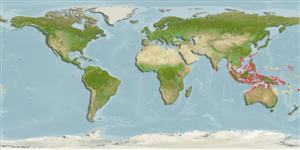Environment: milieu / climate zone / depth range / distribution range
Écologie
marin; eau douce; saumâtre récifal; profondeur 0 - 10 m (Ref. 86942). Tropical; 30°N - 23°S
Indo-West Pacific: Philippines, Indonesia, and New Guinea. Also from New Caledonia, north to Ryukyu Islands, and Palau in Micronesia (Ref. 1602).
Taille / Poids / Âge
Maturity: Lm ? range ? - ? cm
Max length : 10.0 cm TL mâle / non sexé; (Ref. 7050)
Épines dorsales (Total) : 13; Rayons mous dorsaux (Total) : 8; Épines anales: 3; Rayons mous anaux: 5.
Inhabits muddy inshore waters of mangrove swamps and penetrates freshwater rivers (Ref. 1602). Feeds on fishes and crustaceans (Ref. 1602). Possess venom glands at the base of some of the spines.
Life cycle and mating behavior
Maturité | Reproduction | Frai | Œufs | Fécondité | Larves
Kottelat, M., A.J. Whitten, S.N. Kartikasari and S. Wirjoatmodjo, 1993. Freshwater fishes of Western Indonesia and Sulawesi. Periplus Editions, Hong Kong. 221 p. (Ref. 7050)
Statut dans la liste rouge de l'IUCN (Ref. 130435: Version 2024-1)
Utilisations par l'homme
Outils
Articles particuliers
Télécharger en XML
Sources Internet
Estimates based on models
Preferred temperature (Ref.
123201): 27.3 - 29.3, mean 28.8 °C (based on 1625 cells).
Phylogenetic diversity index (Ref.
82804): PD
50 = 0.7500 [Uniqueness, from 0.5 = low to 2.0 = high].
Bayesian length-weight: a=0.01122 (0.00514 - 0.02450), b=3.04 (2.87 - 3.21), in cm total length, based on all LWR estimates for this body shape (Ref.
93245).
Niveau trophique (Ref.
69278): 4.0 ±0.66 se; based on food items.
Résilience (Ref.
120179): Milieu, temps minimum de doublement de population : 1,4 à 4,4 années (Preliminary K or Fecundity.).
Fishing Vulnerability (Ref.
59153): Low vulnerability (10 of 100).
